Xiaomi Redmi Note 11 review
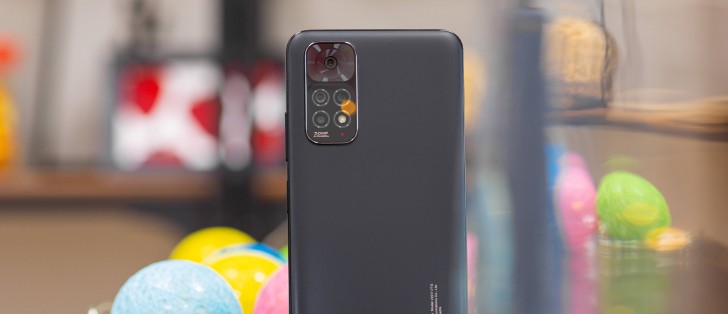
MIUI 13 on top of Android 11
The Xiaomi Redmi Note 11, like the rest of the Redmi Note 11 quartet, boots Android 11 with the most current MIUI 13 version. Most of the new MIUI features are under the hood, though they should make for a smoother, smarter, and more secure experience. The Redmi Note 11 seems to have a few features missing here and there that are present on the Pro models, but we'll get to that.
This version of MIUI 13 is based on Android 11, and it does not include any of the Android 12 features like the revamped widgets and their new widget page in the app drawer. There is no advanced Privacy Dashboard either with options like a protected clipboard, approximate location, updated Face Unlock algorithm. The updated File Manager and Clock app with Bedtime mode are nowhere to be found either.
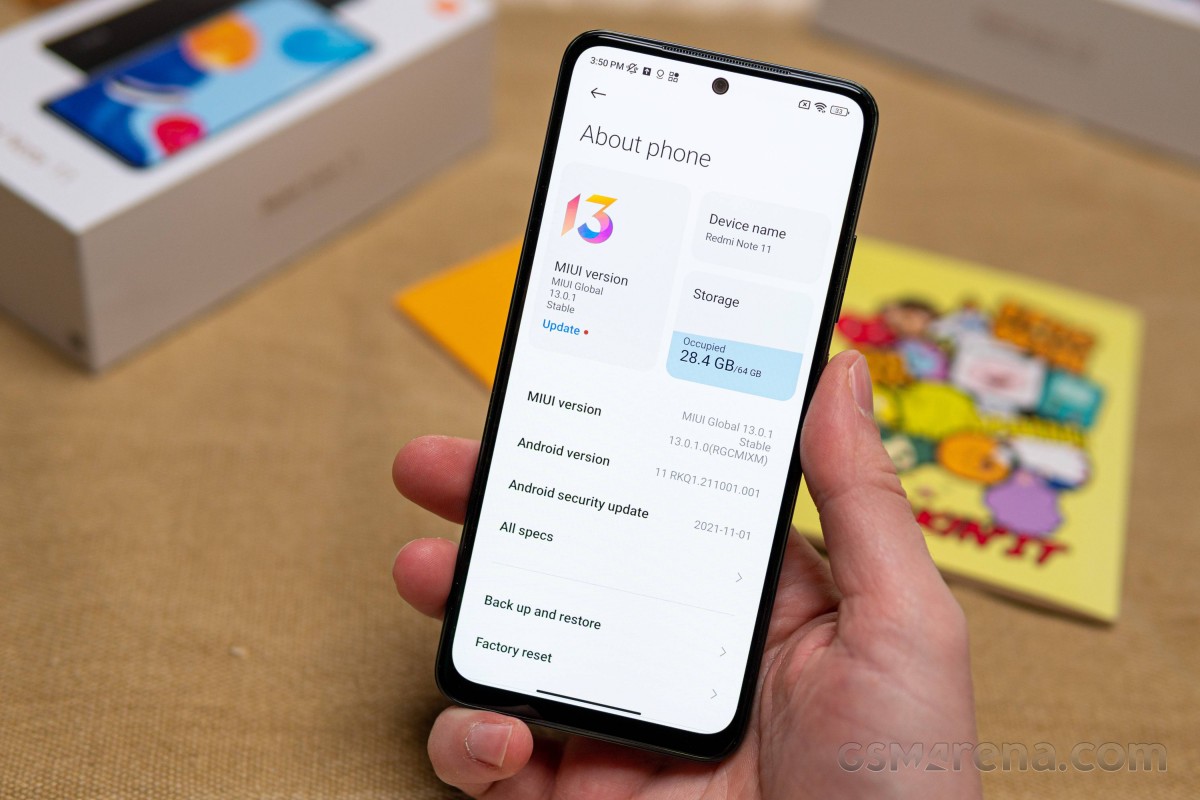
Other notable missing features on Android 11 + MIUI 13 combo are the improved one-handed mode (iOS-style) and the improved camera app with zero shutter lag and motion photos.
Finally, the advertised new live wallpapers showing microscopic stuff like how vitamin C and citric acid crystallize, as part of the Beauty of Science collaboration, are not available on the Redmi Note 11 series just yet.
Still, Xiaomi claims that MIUI has been reworked completely, even if you cannot tell that by the interface and its design alone - it looks and feels just like MIUI 12. But the new version reportedly focuses on better resource distribution and should handle processor, RAM and storage usage smarter.
For example, MIUI 13 is supposed to keep track of current processor and RAM usage and suspend any currently unnecessary tasks to free resources and offer more fluid performance. Xiaomi promises a background process efficiency increase of up to 40% compared to the previous version. Hopefully, that doesn't just mean aggressive background service killing since that has its own set of issues.
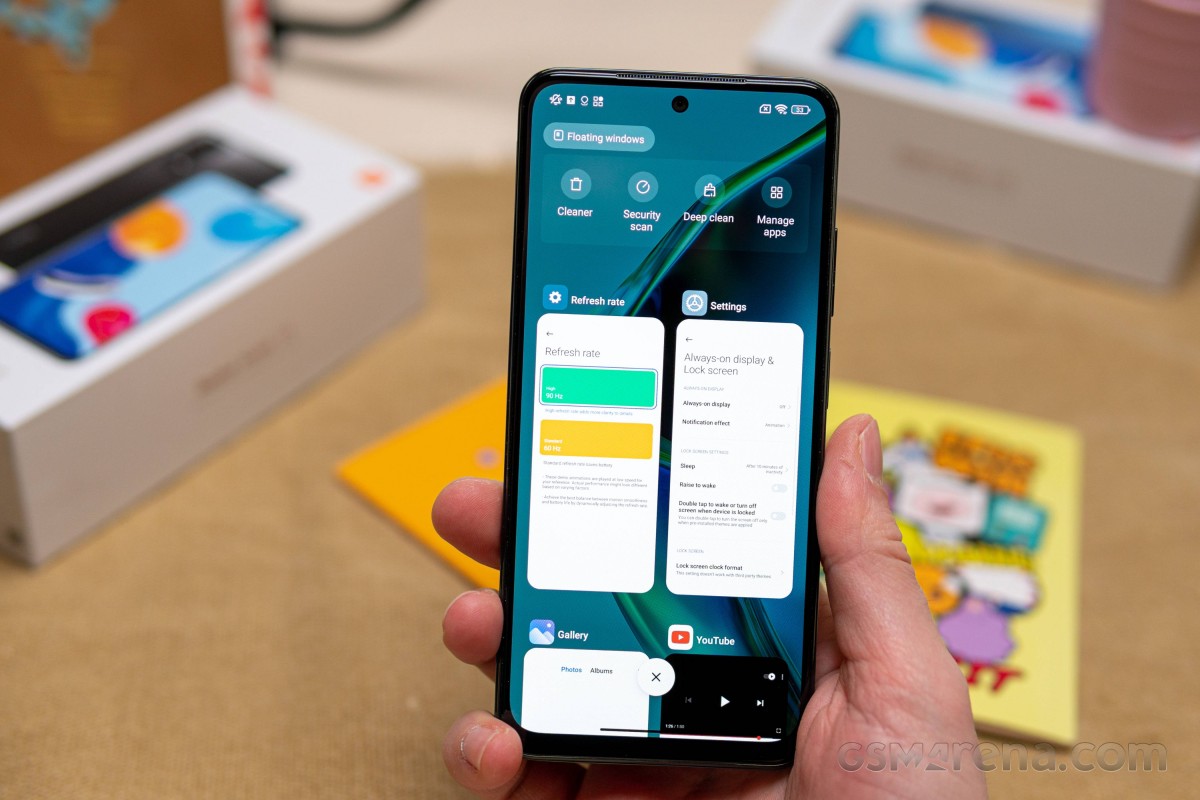
Xiaomi has a new under the hood feature called Liquid storage. The company claims that the storage performance on most phones is halved in 36 months due to inefficient storage management. And this is where MIUI 13 comes in - it offers 60% better defragmentation efficiency than MIUI 12 and other competitors. So, the storage performance drop in 36 months should be merely 5%. This sounds impressive, so here is hoping this feature lives up to the hype.
The new MIUI core also features reworked power management which promises a 10% drop in overall power consumption compared to MIUI 12.
Let's kick the software tour off with the Always-on display. It is present on the Redmi Note 11, but it's not exactly always on. It can only appear for 10s after a tap. At least, there are a lot of AOD themes you can choose from. A few of those can also be customized.
There is a breathing Notification effect baked into the OS. It can work with or without Always-on Display. It's sort of a stand-in for a visual notification alert in place of the absent notification LED.
The lock screen clock style is quite customizable, and you can add some emergency contact info there.






Notification effect and lock screen settings
You unlock the screen via the side-mounted fingerprint scanner. The reader is easy to set up, blazing-fast, and the accuracy is superb. You can set the unlock method to Touch or Press - the Press will spare you accidental misreads of your palm (that eventually lead to PIN input) if you are using the phone without a case. A 2D Face Unlock is available, too, but it is far less secure than the fingerprint option.
There is nothing particularly new or different about the main UI in MIUI 13. Some home screens, as usual with shortcuts, folders and widgets. There is a Google Discover feed on the far left if you choose to enable it.
Just like in MIUI 12, MIUI 13 offers an independent Notification shade and Control Center. You summon them like on the iPhones - pull down from the left part of the screen for the Notification Center, pull down from the right for the Control Center.
If you prefer the traditional combined UX Android typically offers, MIUI 13 does allow you to get that back with a flick of a setting.



Notifications and Control Center
MIUI 13 offers an app drawer. It has a nifty search box, and it automatically organizes your apps into categories. The first is All, meaning it contains all apps. Then follow Communication, Entertainment, Photography, Tools, New, and Business. You can edit these categories or even disable them altogether.
You can disable the app drawer entirely if that's not your thing.
While the task switcher is a familiar Xiaomi affair overall, we did notice some omissions on the Redmi Note 11. Notably, holding down an all-in-the-two-column list does not bring up split-screen options. In fact, after searching high and low, we can only conclude that the Redmi Note 11 lacks a split-screen feature altogether. Perhaps Xiaomi deemed the experience not good enough on its weaker chipset? We can't say for sure.
You can still spawn a single Floating Window app at any time, though. There is an interface for that above the two recent apps columns. The app needs to support free form mode, too.



Task switcher and floating windows, but not split-screen
Themes have always been a huge part of MIUI, and they are available on MIUI 13, too. You can download new ones from the Themes store, and they can change wallpapers, ringtones, system icons, and even the always-on display style.
There are a few proprietary apps in MIUI. Some of these include Gallery, Music, Mi Video (with streaming options), FM radio. There is also an MIUI File Manager. And, of course, a Mi Remote app that uses the integrated IR blaster.






Gallery • Music • Video • FM Radio • File Manager • Mi Remote
The default image editor baked into the Gallery app has a nifty new Protective watermark feature. It can overlay a pro-looking custom watermark text for you.
MIUI also offers a Security app. It is a nice centralized hub that can scan your phone for malware, manage your blacklist, manage or restrict your data usage, configure battery behavior, and free up some RAM. It can also manage the permissions of your installed apps, define the battery behavior of selected apps, and apply restrictions only to certain apps.
And speaking of memory, MIUI 13 offers Memory Extension option that's active by default (you can disable it if you like). Our Redmi Note 11 extends the 4GB of RAM with an additional 1GB of virtual RAM. The Redmi Note 11 Pro unit we recently reviewed had an extra 3GB of virtual memory.
Another thing we were expecting to see on the Redmi Note 11 since it is present on the Redmi Note 11 Pro models is the Xiaomi Smart Sidebar. In a rather odd twist, it is not all there, yet not entirely missing either. There is no option called Smart Sidebar, but the Special features menu does still include a Video toolbox, which is one of the more interesting features housed within the Smart Sidebar. Enable that for your choice of "video apps", and you end up with a familiar little area on the left side that you can swipe from and get what is essentially the Smart Sidebar, just notably missing audio options. You can still use it to launch apps in pop-up windows, Screenshot, Record screen, Cast, and Play Video with the screen off. And, oh yes, the last one works on YouTube, no Premium subscription needed!





No Smart Sidebar, but screen off video playback is still present
Other interesting MIUI 13 improvements you may not notice at first include a better screenshot editor, a brand-new battery page.
When you take a screenshot, you will notice a modern-looking interface with brushes, erasers, text and selection tools, among others.
The battery page on the Redmi Note 11 has a new look and offers some extra info like battery temperature but lacks the new Performance mode found on the Redmi Note 11 Pro 5G. Not that it is particularly useful, to begin with. You just have the default mode and two power-saver levels.
Another extra feature on the Redmi Note 11 Pro 5G missing from the Redmi Note 11 is the toggle to enable video capture with the screen off within the camera app. Again, not a deal-breaking omission, but a noteworthy one.






Camera settings • Screenshot editor • Battery manager
Some MIUI ROMs include ads in the default apps. On our review units, the Redmi Note 11 Pro doesn't have any ads, but the Redmi Note 11, the Redmi Note 11S and the Redmi Note 11 Pro 5G version did come with baked-in ad "recommendations".
You can disable those even if it's a bit tedious to do it because you have to do it for every system app that has them. For example, if you are annoyed by the app scanner's ads, just hit the settings gear, and disable recommendations. Ads in the File Manager - Settings->About should do it. Themes - go to Settings and disable Recommendations. It's not ideal, sure, but at least you can get rid of them all.



Disabling the Ads only happens from every app manually
MIUI 13 has a lot of under the hood improvements that promise a smoother and faster experience right now and for the next couple of years due to many optimizations. The interface is pretty much MIUI 12 with a couple of tweaks here and there. So, if you didn't expect a groundbreaking redesign, you will feel right at home with MIUI 13. We don't expect Android 12 to change that either.
Overall, MIUI 13 on the Redmi Note 11 runs decently smooth, despite all of the extra visual flair. There are no stutters, but the occasional slowdown does happen. The Snapdragon 680 seems to be straining quite a bit. While fine out of the box, we already see the potential for lagging after installing and running a few heavier apps. To that end, we hope that Xiaomi's MIUI 13 under the hood optimization really do deliver as promised.
Performance and benchmarks
The budget smartphone scene is constantly improving and has done so in leaps and bounds over the last few years, much to the user's benefit. The Redmi Note 11 is a sub-EUR 200 device, and it still delivers features such as a solid 90Hz AMOLED display, stereo speakers, a decent camera setup and a big 5,000 mAh battery that charges at a respectable 33W, just to name a few. Even so, as the saying goes, something has to give, and in this particular case, the Snapdragon 680 chipset is arguably one of the weakest parts of the Redmi Note 11.
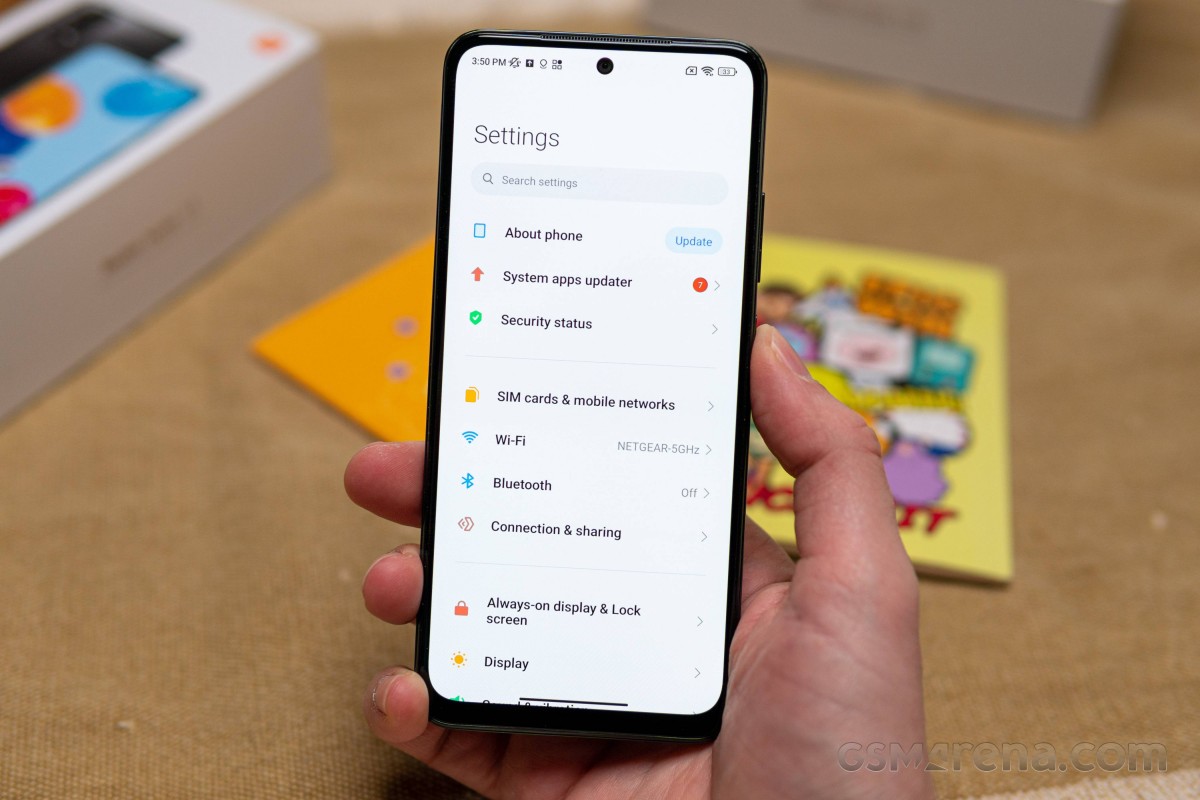
On the surface, the Snapdragon 680 (SM6225) is a modern chip. It was released in Q4 2021 and is made on a current and efficient TSMC 6nm node. Once you start reading into some of its other specs in detail, though, some major compromises start to show through. For one, its four "big" Kryo 265 Gold cores are based on the ARM Cortex-A73 from all the way back in 2016, while the Cortex-A53 base for the "LITTLE" Kryo 265 Silver ones was unveiled in 2012. Both are several generations old and can't really keep up with more potent and recent CPU cores. The Snapdragon 680 has these set up in a 4x2.4 GHz Kryo 265 Gold & 4x1.9 GHz Kryo 265 Silver configuration.
Then there is the Adreno 610 GPU - another aging piece of kit that is almost operating at its maximum supported display resolution limit of 2520x1080 pixels on the Redmi Note 11, with its 1080 x 2400 resolution display. That should be indication enough for its performance. We are almost wondering how it is managing 90Hz or rather anywhere close to 90fps at all. The Spectra 346 camera ISP and Hexagon 686 DSP of the Snapdragon 680 are nothing to phone home about either and are the reason why the Redmi Note 11 is only limited to 1080p video capture. By the way, the Snapdragon 695 is even more of a disappointment than the Snapdragon 680 in this regard since it shares this limitation, while the older and "lower number" Snapdragon 690 doesn't. But, we are getting off-topic.
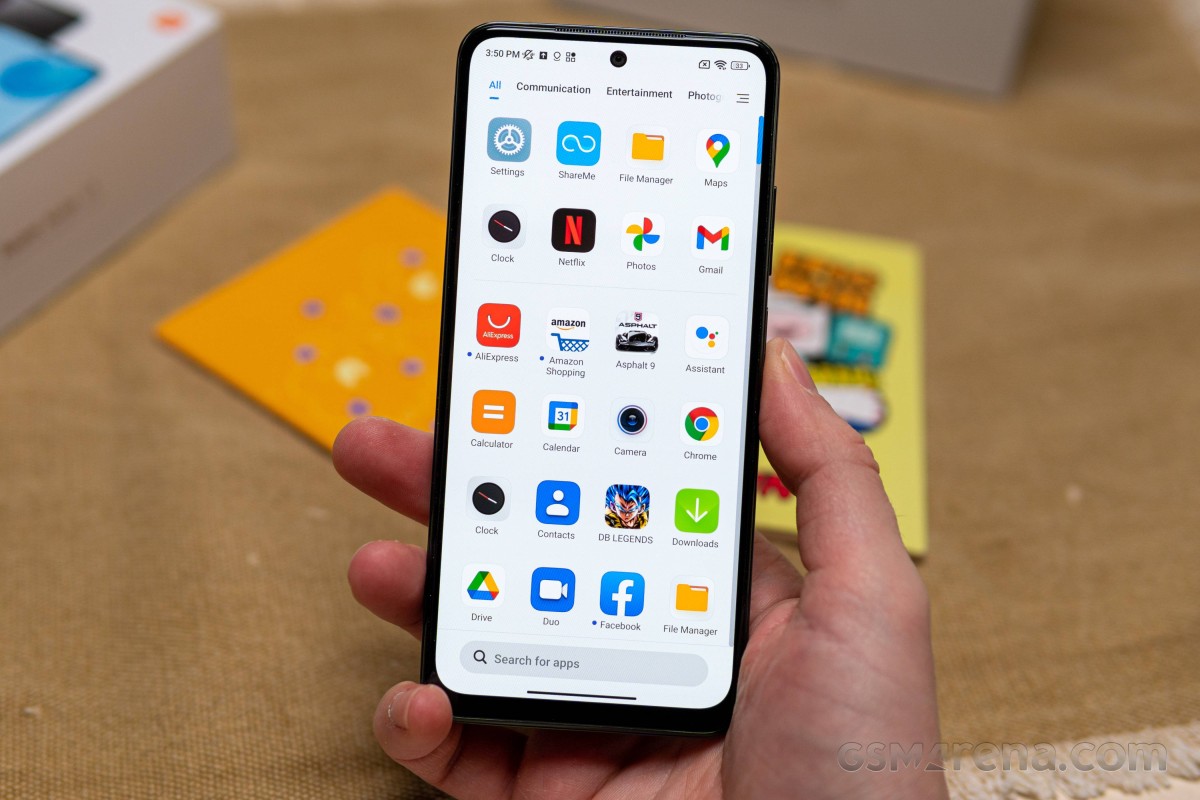
Continuing the list of less-than-impressive Snapdragon 680 features, we have the X11 LTE modem, which is rated at Cat. 13 speeds, capped at 390 Mbps down and 150 Mbps up. Quick Charge 3+ support is also a bit old, but still, plenty fast, plus the Redmi Note 11 supports Power Delivery 3.0, as well, so we have less of a quarrel with that, and we can't complain of the other abundant and fairly modern connectivity on the phone like Bluetooth, NFC, GPS, IR blaster, to name a few.
For the sake of thoroughness, we are running these benchmarks on a base Redmi Note 11 unit with 4GB of LPDDR4X RAM and 64GB of UFS 2.2 internal storage.
Let's kick things off with some pure CPU loads and GeekBench. The Snapdragon 680 holds up decently well here. You can expect comparable performance to a MediaTek G80 or G95. Not far from the Dimensity 700 or 720, depending on the loads you are looking at. Not too shabby.
GeekBench 5 (multi-core)
Higher is better
-
Xiaomi 11 Lite 5G NE
2832 -
Infinix Zero 5G
2169 -
Xiaomi Redmi Note 11 Pro 5G
2063 -
Poco M4 Pro 5G
1797 -
Xiaomi Redmi Note 10 Pro
1780 -
Poco X3 NFC
1777 -
Xiaomi Redmi Note 11 Pro
1729 -
Samsung Galaxy A22 5G
1719 -
Realme 8
1690 -
Samsung Galaxy A32 5G
1673 -
Xiaomi Redmi Note 11
1662 -
Infinix Note 10 Pro
1644 -
Xiaomi Redmi Note 10
1599 -
Realme 9i
1581 -
Samsung Galaxy A22
1372 -
Xiaomi Redmi Note 8 2021
1314 -
Xiaomi Redmi 10
1294 -
Samsung Galaxy A32
1277 -
Nokia G21
1193 -
Samsung Galaxy A12
1034
GeekBench 5 (single-core)
Higher is better
-
Xiaomi 11 Lite 5G NE
787 -
Infinix Zero 5G
706 -
Xiaomi Redmi Note 11 Pro 5G
688 -
Poco M4 Pro 5G
597 -
Xiaomi Redmi Note 10 Pro
569 -
Poco X3 NFC
568 -
Samsung Galaxy A22 5G
560 -
Xiaomi Redmi Note 10
534 -
Realme 8
533 -
Xiaomi Redmi Note 11 Pro
511 -
Infinix Note 10 Pro
510 -
Samsung Galaxy A32 5G
505 -
Realme 9i
384 -
Xiaomi Redmi Note 11
376 -
Samsung Galaxy A22
376 -
Xiaomi Redmi 10
361 -
Samsung Galaxy A32
361 -
Xiaomi Redmi Note 8 2021
352 -
Nokia G21
311 -
Samsung Galaxy A12
169
On a side note, it is good to see that the Redmi Note 11 is scoring very similarly to the Redmi 9i, which has the same Snapdragon 680 chipset. Good in relative terms, of course, since consistency is appreciated.
That goes for the compound benchmark AnTuTu with its mix of various tests, including GPU runs and tests on memory and storage. A middle-of-the-pack result is not too bad, but if you are willing to go for slightly older or slightly more expensive devices, you can get much better overall performance.
AnTuTu 8
Higher is better
-
Infinix Zero 5G
419083 -
Infinix Note 10 Pro
310342 -
Realme 8
298328 -
Poco M4 Pro 5G
296721 -
Xiaomi Redmi Note 10 Pro
295442 -
Xiaomi Redmi Note 11 Pro 5G
288914 -
Poco X3 NFC
283750 -
Xiaomi Redmi Note 11 Pro
261309 -
Samsung Galaxy A22 5G
242155 -
Realme 9i
229368 -
Xiaomi Redmi Note 11
228044 -
Samsung Galaxy A32 5G
226561 -
Xiaomi Redmi Note 10
218788 -
Samsung Galaxy A22
185358 -
Xiaomi Redmi Note 8 2021
180195 -
Samsung Galaxy A32
174332 -
Samsung Galaxy A12
107189
AnTuTu 9
Higher is better
-
Xiaomi 11 Lite 5G NE
527663 -
Infinix Zero 5G
487639 -
Xiaomi Redmi Note 11 Pro 5G
382902 -
Infinix Note 10 Pro
365490 -
Realme 8
357488 -
Poco M4 Pro 5G
353663 -
Xiaomi Redmi Note 11 Pro
319093 -
Xiaomi Redmi Note 11
244526 -
Samsung Galaxy A22 5G
223188 -
Samsung Galaxy A32 5G
222125 -
Nokia G21
171299 -
Samsung Galaxy A22
165959 -
Xiaomi Redmi Note 8 2021
165779
There is no point beating about the bush, the Adreno 610 GPU is rather disappointing on a 2022 device. It gets beaten out by pretty much any other hardware in the price range, sans for the MediaTek Helio P35 inside the Samsung Galaxy A12 and the odd Unisoc T606 powering the Nokia G21.
GFX Aztek ES 3.1 High (onscreen)
Higher is better
-
Xiaomi 11 Lite 5G NE
19 -
Infinix Zero 5G
14 -
Realme 8
12 -
Infinix Note 10 Pro
12 -
Poco X3 NFC
11 -
Samsung Galaxy A22
9.2 -
Samsung Galaxy A22 5G
8.4 -
Nokia G21
6 -
Xiaomi Redmi Note 10
5.6 -
Xiaomi Redmi Note 8 2021
5.4 -
Samsung Galaxy A32
5 -
Xiaomi Redmi Note 11
4.6 -
Samsung Galaxy A12
4.6
GFX Aztek ES 3.1 High (offscreen 1440p)
Higher is better
-
Xiaomi 11 Lite 5G NE
13 -
Infinix Zero 5G
10 -
Realme 8
7.7 -
Infinix Note 10 Pro
7.7 -
Samsung Galaxy A22 5G
5.5 -
Xiaomi Redmi Note 10
3.7 -
Xiaomi Redmi Note 8 2021
3.4 -
Samsung Galaxy A22
3.3 -
Samsung Galaxy A32
3.3 -
Xiaomi Redmi Note 11
3.1 -
Nokia G21
1.9 -
Samsung Galaxy A12
1.5
GFX Aztek Vulkan High (onscreen)
Higher is better
-
Xiaomi 11 Lite 5G NE
20 -
Infinix Zero 5G
13 -
Realme 8
11 -
Infinix Note 10 Pro
11 -
Poco X3 NFC
11 -
Samsung Galaxy A22
9.4 -
Samsung Galaxy A22 5G
7.8 -
Nokia G21
5.6 -
Xiaomi Redmi Note 10
5.3 -
Xiaomi Redmi Note 11
4.8 -
Xiaomi Redmi Note 8 2021
4.7 -
Samsung Galaxy A32
4.4 -
Samsung Galaxy A12
3.8
GFX Aztek Vulkan High (offscreen 1440p)
Higher is better
-
Xiaomi 11 Lite 5G NE
14 -
Infinix Zero 5G
9.5 -
Realme 8
7.5 -
Infinix Note 10 Pro
7.5 -
Samsung Galaxy A22 5G
5.1 -
Xiaomi Redmi Note 10
3.5 -
Xiaomi Redmi Note 8 2021
3.1 -
Xiaomi Redmi Note 11
3.1 -
Samsung Galaxy A22
2.9 -
Samsung Galaxy A32
2.9 -
Nokia G21
1.8 -
Samsung Galaxy A12
1.2
Honestly, sitting through multiple runs on some of the more difficult tests was just excruciating. To be fair, though, chips like the Helio G80 or G85 aren't that much better in GPU terms. The Helio G96, and particularly the G95, though, as well as most of the Dimensity chips out there, will give you tangibly better performance.
GFX Car Chase ES 3.1 (onscreen)
Higher is better
-
Xiaomi 11 Lite 5G NE
28 -
Infinix Zero 5G
19 -
Realme 8
18 -
Xiaomi Redmi Note 11 Pro 5G
17 -
Infinix Note 10 Pro
17 -
Xiaomi Redmi Note 10 Pro
16 -
Samsung Galaxy A22
16 -
Poco X3 NFC
16 -
Poco M4 Pro 5G
13 -
Xiaomi Redmi Note 11 Pro
12 -
Samsung Galaxy A22 5G
12 -
Nokia G21
8.9 -
Xiaomi Redmi Note 8 2021
8.7 -
Samsung Galaxy A32
8.1 -
Xiaomi Redmi Note 10
7.9 -
Realme 9i
7.3 -
Xiaomi Redmi Note 11
6.8 -
Samsung Galaxy A12
5
GFX Car Chase ES 3.1 (offscreen 1080p)
Higher is better
-
Xiaomi 11 Lite 5G NE
33 -
Infinix Zero 5G
25 -
Realme 8
20 -
Infinix Note 10 Pro
20 -
Xiaomi Redmi Note 10 Pro
19 -
Xiaomi Redmi Note 11 Pro 5G
19 -
Poco X3 NFC
19 -
Poco M4 Pro 5G
16 -
Xiaomi Redmi Note 11 Pro
14 -
Samsung Galaxy A22 5G
14 -
Xiaomi Redmi Note 8 2021
9.6 -
Xiaomi Redmi Note 10
9.3 -
Samsung Galaxy A22
9.3 -
Samsung Galaxy A32
9.3 -
Realme 9i
8.2 -
Xiaomi Redmi Note 11
8 -
Nokia G21
5.2 -
Samsung Galaxy A12
3.3
GFX Manhattan ES 3.1 (onscreen)
Higher is better
-
Xiaomi 11 Lite 5G NE
49 -
Infinix Zero 5G
35 -
Xiaomi Redmi Note 11 Pro 5G
34 -
Samsung Galaxy A22
30 -
Realme 8
29 -
Infinix Note 10 Pro
28 -
Poco X3 NFC
27 -
Poco M4 Pro 5G
23 -
Xiaomi Redmi Note 11 Pro
22 -
Samsung Galaxy A22 5G
21 -
Nokia G21
17 -
Xiaomi Redmi Note 10
15 -
Xiaomi Redmi Note 8 2021
14 -
Realme 9i
14 -
Samsung Galaxy A12
13 -
Samsung Galaxy A32
13 -
Xiaomi Redmi Note 11
12
GFX Manhattan ES 3.1 (offscreen 1080p)
Higher is better
-
Xiaomi 11 Lite 5G NE
56 -
Infinix Zero 5G
43 -
Realme 8
33 -
Infinix Note 10 Pro
33 -
Poco X3 NFC
33 -
Xiaomi Redmi Note 11 Pro 5G
30 -
Poco M4 Pro 5G
26 -
Xiaomi Redmi Note 11 Pro
24 -
Samsung Galaxy A22 5G
24 -
Realme 9i
23 -
Xiaomi Redmi Note 10
17 -
Xiaomi Redmi Note 8 2021
16 -
Xiaomi Redmi Note 11
15 -
Samsung Galaxy A22
15 -
Samsung Galaxy A32
15 -
Nokia G21
8.5 -
Samsung Galaxy A12
7.7
GFX Manhattan ES 3.0 (onscreen)
Higher is better
-
Xiaomi 11 Lite 5G NE
68 -
Infinix Zero 5G
57 -
Realme 8
48 -
Infinix Note 10 Pro
48 -
Samsung Galaxy A22
42 -
Xiaomi Redmi Note 11 Pro 5G
41 -
Poco M4 Pro 5G
37 -
Xiaomi Redmi Note 11 Pro
34 -
Poco X3 NFC
33 -
Samsung Galaxy A22 5G
31 -
Nokia G21
24 -
Xiaomi Redmi Note 8 2021
22 -
Xiaomi Redmi Note 10
21 -
Samsung Galaxy A32
21 -
Realme 9i
20 -
Samsung Galaxy A12
19 -
Xiaomi Redmi Note 11
18
GFX Manhattan ES 3.0 (offscreen 1080p)
Higher is better
-
Xiaomi 11 Lite 5G NE
78 -
Infinix Zero 5G
64 -
Infinix Note 10 Pro
54 -
Realme 8
53 -
Xiaomi Redmi Note 11 Pro 5G
47 -
Poco X3 NFC
44 -
Poco M4 Pro 5G
40 -
Xiaomi Redmi Note 11 Pro
37 -
Samsung Galaxy A22 5G
32 -
Xiaomi Redmi Note 8 2021
25 -
Xiaomi Redmi Note 10
24 -
Samsung Galaxy A22
24 -
Samsung Galaxy A32
24 -
Realme 9i
23 -
Xiaomi Redmi Note 11
21 -
Nokia G21
14 -
Samsung Galaxy A12
12
3D mark paints nearly the exact same grim picture.
3DMark SSE ES 3.1 (offscreen 1440p)
Higher is better
-
Xiaomi 11 Lite 5G NE
4979 -
Infinix Zero 5G
3845 -
Infinix Note 10 Pro
2748 -
Poco X3 NFC
2689 -
Samsung Galaxy A32 5G
2638 -
Realme 8
2610 -
Samsung Galaxy A22 5G
2391 -
Xiaomi Redmi Note 10
1471 -
Xiaomi Redmi Note 8 2021
1399 -
Samsung Galaxy A22
1361 -
Realme 9i
1339 -
Samsung Galaxy A32
1323 -
Xiaomi Redmi Note 11
1316 -
Nokia G21
962 -
Samsung Galaxy A12
365
3DMark SSE Vulkan 1.0 (offscreen 1440p)
Higher is better
-
Xiaomi 11 Lite 5G NE
4608 -
Infinix Zero 5G
3558 -
Infinix Note 10 Pro
2854 -
Realme 8
2639 -
Samsung Galaxy A32 5G
2509 -
Poco X3 NFC
2495 -
Samsung Galaxy A22 5G
2257 -
Xiaomi Redmi Note 8 2021
1424 -
Samsung Galaxy A22
1383 -
Xiaomi Redmi Note 10
1372 -
Samsung Galaxy A32
1371 -
Realme 9i
1291 -
Xiaomi Redmi Note 11
1267 -
Nokia G21
930 -
Samsung Galaxy A12
612
3DMark Wild Life Vulkan 1.1 (offscreen 1440p)
Higher is better
-
Xiaomi 11 Lite 5G NE
2477 -
Infinix Zero 5G
2035 -
Infinix Note 10 Pro
1506 -
Realme 8
1486 -
Poco M4 Pro 5G
1232 -
Xiaomi Redmi Note 11 Pro 5G
1204 -
Samsung Galaxy A32 5G
1185 -
Samsung Galaxy A22 5G
1104 -
Xiaomi Redmi Note 11 Pro
1101 -
Xiaomi Redmi Note 8 2021
722 -
Samsung Galaxy A22
691 -
Samsung Galaxy A32
686 -
Xiaomi Redmi Note 10
482 -
Realme 9i
452 -
Xiaomi Redmi Note 11
439 -
Nokia G21
403
At least we still get consistent scores from the Redmi Note 11 both compared to the Redmi 9i and across OpenGL and Vulkan renderers, and even while struggling to push frames, rendering remained stable and crash-free.
That's not much of a consolation, though, if you are after a good gaming experience. The Redmi Note 11 and its Snapdragon 680 just don't have the graphics power for anything more than the most casual games. To be clear, most titles out there will still run due to the extremely flexible and scalable nature of modern mobile game engines, but not nearly good enough to deliver an adequate experience. If gaming is a priority for you, look elsewhere.
On the plus side, thanks to its modern 6nm manufacturing process and its limited performance, the Snapdragon 680 and the Redmi Note 11 don't struggle with heat in any meaningful way. Thermal throttling tests show hardly show any performance losses along the way and the surface of the Redmi Note 11 never really heated up in any noticeable way.



Thermal throttling tests on the Redmi Note 11
And on another important positive note, despite some of its raw performance deficiencies, the Redmi Note 11 never had any issues actually running MIUI 13 smoothly at all. Slowdowns were few and far between, with practically no stutters while doing everyday tasks and running things like social networks and productivity apps.
We won't make any excuses for Xiaomi here; the Redmi Note 11 is not a powerful device by any means. In some aspects, it is not even as powerful as its predecessor - the Redmi Note 10. You can get much better numbers for your money elsewhere. Still, if you don't intend to game much on your phone, these performance deficiencies aren't nearly as prominent or a dealbreaker.
Reader comments
- Ised
- 07 Dec 2024
- waU
Redmi Note 11 my phone device open me
- Burdi
- 05 Dec 2024
- 6Qg
This is in fact good phone ... I'm using it since last 2 years
- Farhad
- 09 Nov 2024
- 6p}
Network problem









































